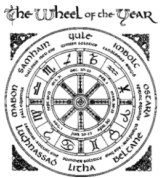


















The Sabbats
Ideas for Celebration. Samhain - October 31
Samhain - October 31 Samhain or Hallowe'en begins the Celtic New Year, the time where the Veil between mortal and spirit is thin. During this time the dead come back to visit their homes and loved ones. We may find ourselves more psychically aware and able to communicate with friends and family who have passed on. Magick done at this time is for preservation through the winter months and to strengthen the Sun for His rebirth at Yule.
To celebrate Samhain you might
*Carve pumpkins
*Perform divinations for the upcoming year
*Prepare a Feast of the Dead
*Share stories about relatives who have passed on
 Yule - December 21
Yule - December 21Yule or Winter Solstice celebrates the rebirth of the Sun child. Most modern Christmas celebrations are modified Pagan customs. Santa Claus or Kris Kringle comes from the Norse traditions. During the Yule season's stormy nights, Odin rides his eight-footed horse throughout the world bestowing gifts on worthy people and dispensing justice to the wrong doers. Kris Kringle ("Christ of the Wheel") is the title of the Norse god born at Winter Solstice. Our ancestors believed that by decorating with evergreen plants such as holly, mistletoe, and ivy, they were helping to bring the Sun through a dangerous time of diminished light.
To celebrate Yule you might:
*Decorate a Yule tree after sharing with your family why we bring green things into our homes at this time
*Make your own tree decorations like strings of cranberries and pop corn (corn being a symbol of the God)
 Imbolc - February 1
Imbolc - February 1Imbolc is a time of purification, preparation, and celebration for new life stirrings that always happens in Spring. In the Catholic calendar it is know as St. Brigit's day or Candlemas. The custom of blessing candles signifies the awakening of life and honors the goddess Brigit, who was the only Goddess of the Celtic pantheon brought forward into traditional Christian worship. Fire is sacred to Bride.
To celebrate Imbolc you could:
*Carry out rites of self purification
*Burn the mistletoe, holly, and ivy decorations from Yule to signify the end of harsh weather and old ways
*Appoint one person to "awaken the earth" during ritual. He or she goes to the ritual circle's north quarter and beats upon the ground, calling out for Mother Earth to wake up.
 Ostara - March 21
Ostara - March 21Ostara or Spring Equinox is light and dark balanced with light gaining power. It's the turning point from Winter to Spring. It is the beginning of the agricultural year, and its rights ensure crops and fertility of the flocks. Now is the time of planting, nurturing, and growth. The God and Goddess begin their courtship.
To celebrate Ostara:
*Spring cleaning is a great way to clear out the old and make room for the new. Donate old clothes, books, toys, etc.
*Dye Spring Equinox Eggs
*Explain to family the Easter bunny's origins. The hare or rabbit is sacred to Diana/Artemis. Rabbits are very fertile. They represent the fertility that is beginning. When the bunny brings gifts of eggs, it's bringing the gift of renewal.
*Bless some seeds with a wish and plant them. As the seeds grow, the wish comes true.
 Beltane - May 1
Beltane - May 1Beltane honors the union of the God and Goddess and the beginning of the fertile Goddess's reign. We see Her power in the growing, flowering plants and warm days.
How to celebrate Beltane:
*Erect a Maypole (symbol of the God's fertility) and decorate it with flowers and ribbons. Enjoy weaving a dance with the ribbons around the pole.
*Decorate baskets with fruits and flowers to give as gifts
*Make fresh flower wreaths to wear in your hair
*Build a small bonfire and jump over it to stimulate fertility of the mind and body
*Wash your face with morning dew for beauty
 Litha - June 21
Litha - June 21Litha or Summer Solstice or Midsummer is the longest day of the year and celebrates the Sun at the height of his power. It includes the elements of Fire and Water for the sacred marriage of the God and Goddess and to acknowledge the need for the Sun and the rain to help the crops grow.
Something to do for Litha:
*Play with the children in the water or sprinklers
*Have a picnic in a park
*Bless some water and then water the plants you planted on Ostara
*Decorate your front door with birch boughs, fennel, and roses
*Make a bird feeder
 Lammas - August 1
Lammas - August 1Lammas or Lughnasadh honors the Sun god Lugh, ripener of grains. These rites thank Him for His gifts. It is a time to bless the garden, beehives (because bees help pollinate plants), and harvest tools.
You could celebrate Lammas by:
*If you have a spring or well in your area, bless it and decorate it with flowers
*Harvest the first crops of your garden and dedicate them to the Gods. If you don't have a garden, take a trip to a farmer's market or grocery store and purchase some fruit and vegetables.
*Bake some bread
*Float flowers at a local creek or pond
*Take a nature walk and collect goodies for your altar with your Tin-Can Caddy
 Mabon - September 21
Mabon - September 21Mabon or Autumn or Fall Equinox is a time of thanksgiving for the harvest that has been accomplished. It's a time of bidding farewell to summer and of honoring the family and friendship bonds.
You could celebrate Mabon in this way:
*Have a thanksgiving feast. Bake Acorn Squash with Apples
*Have family members tell what they are thankful for and what they have learned this year.
*Can and preserve produce
*Make and decorate Cornucopias